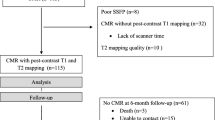Abstract
Changes of myocardial oxygenation can be studied by measurements of the apparent transverse relaxation timeT *2 , which is correlated with the oxygenation state of hemoglobin. In this study, ten patients with coronary artery disease (CAD) underwent blood oxygenation level dependent (BOLD)T *2 measurements using a segmented gradient echo pulse sequence with ten echoes.T *2 measurements were performed in a single short-axis slice of the heart at rest and under pharmacological stress with dipyridamole (DIP), which increases myocardial blood flow. For comparison, all patients underwent X-ray angiography and stress-echocardiography within 4 days after the MR exam. In one patient, MR examination was repeated 10 weeks after percutaneous transluminal coronary angioplasty (PTA). In the differentialT *2 maps, expected ischemic areas of myocardium were identified in six patients. In these regions,T *2 values (30±8 ms) were significantly reduced when compared to the remaining myocardium (48±9 ms,P<0.01). In four patients, the myocardial region of interest could not be assessed owing to severe susceptibility artifacts in the ischemic region. The success of the PTA treatment could be visualized from a more homogeneous DIP induced increase inT *2 within the ischemic myocardium (from 26±1 to 29±1 ms before PTA versus 26±1 to 31±4 ms after PTA,P<0.001.
Similar content being viewed by others
References
Ogawa S, Lee TM, Kay AR, Tank DW. Brain magnetic resonance imaging with contrast dependent on blood oxygenation. Proc Natl Acad Sci USA 1990; 87:9868–72.
Ogawa S, Tank DW, Menon R, Ellerman JM, Kim SG, Merkle H, Urgubil K. Intrinsic signal changes accompanying sensory stimulation: functional brain mapping with magnetic resonance imaging. Proc Natl Acad Sci USA 1992;89:5951–5.
Li D, Dhawale P, Rubin PJ, Haacke EM, Gropler RJ. Myocardial signal response to dipyridamole and dobutamine: demonstration of the BOLD effect using a double-echo gradient-echo sequence. Magn Reson Med 1996;36:16–20.
Wacker CW, Bock M, Hartlep AW, et al. Oxygenation and perfusion measurements in the human heart under pharmacological stress with dipyridamole. 6th Scientific Meeting of the ISMRM, Sydney. Book of Abstracts 1998, p. 897.
Wacker CW, Bock M, Hartlep AW, Beck G, van Kaick G, Ertl G, Bauer WR, Schad LR. Changes in myocardial oxygenation and perfusion under pharmacological stress with dipyridamole: assessment usingT *2 andT 1 measurements. Magn Reson Med, 1999 in press.
Atkinson D, Brant Zawadzki M, Gillan G, Purdy D, Laub G. Improved MR angiography: magnetization transfer suppression with variable flip angle excitation and increased resolution. Radiology 1994;190(3):890–4.
Bauer WR, Nadler W, Bock M et al. Theory of the BOLD effect in the capillary region: an analytical approach for the determination ofT *2 in the capillary network of myocardium. Magn Reson Med 1999;41:51–62.
Reeder SB, Faranesh AZ, McVeigh ER. In vivo measurement ofT *2 and field inhomogeneity: implications for cardiac EPI. 6th Scientific Meeting of the ISMRM, Sydney, Book of abstracts, 1998, p. 797.
Atalay MK, Poncelet BP, Kantor HL, Brady TJ, Weisskoff RM. Susceptibility artifact at the cardiac apex of porcine hearts at 3T is primarily due to the heart-lung interface. 6th Scientific Meeting of the ISMRM, Sydney, Book of abstracts, 1998, p. 130.
McGuinness ME, Talbert RL. Pharmacological stress testing: experience with dipyridamole, adenosine and dobutamine. Am J Hosp Pharm 1994;51(3):328–46.
Tauchert M, Hilger HH. In: Schaper W, editor, The pathophysiology of myocardial perfusion. Amsterdam: Elsevier/North Holland Biomedical Press, 1979:141.
Bing RJ, Hammond MM, Handelsman, JC, Powers SR, Spenger FC, Eckenhoff JE, Goodale WT, Hafkenschiel JH, Kety SS. The measurement of coronary blood flow, oxygen consumption, and efficiency of the left ventricle in man. Am Heart J 1949;38:1.
Niemi P, Poncelet BP, Kwong KK, et al. Myocardial intensity changes associated with flow stimulation in blood oxygenation sensitive magnetic resonance imaging. Magn Reson Med 1996;36:78–82.
Kaul S, Jayaweera AR. Coronary and myocardial blood volumes. Circulation 1997;96:719–24.
Atalay MK, Reeder SB, Zerhouni EA, Forder JR. Blood oxygenation dependence ofT 1 andT 2 in the isolated, perfused rabbit heart at 4.7 T. Magn Reson Med 1995;34:623–7.
Janick PA, Hackeney DB, Grossmann RI, Asakura T. MR imaging of various oxidation states of intracellular and extracellular hemoglobin. AJNR 1991;12:891–7.
Author information
Authors and Affiliations
Corresponding author
Rights and permissions
About this article
Cite this article
Wacker, C.M., Bock, M., Hartlep, A.W. et al. BOLD-MRI in ten patients with coronary artery disease: evidence for imaging of capillary recruitment in myocardium supplied by the stenotic artery. MAGMA 8, 48–54 (1999). https://doi.org/10.1007/BF02590635
Received:
Accepted:
Issue Date:
DOI: https://doi.org/10.1007/BF02590635




